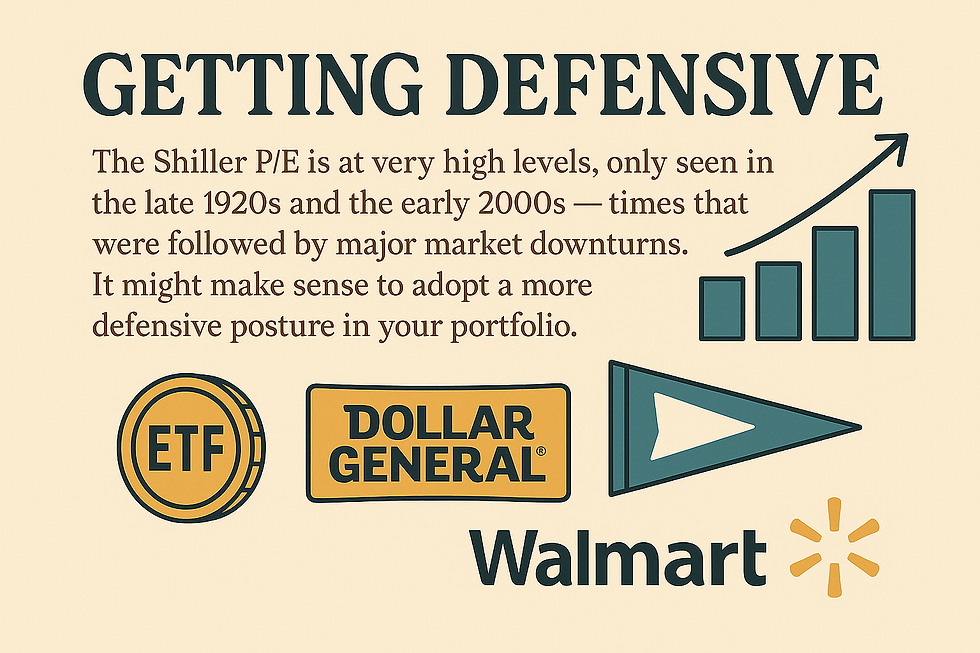When Prices Float Too High: The Shiller Signal and the Shape of Things to Come
- dimepop editorial staff

- Nov 12
- 3 min read

“The market can stay irrational longer than you can stay solvent.”— John Maynard Keynes
There’s a shimmer to the stock market right now — a kind of feverish light. The indexes glow at all-time highs, AI narratives hum in every headline, and yet a quieter metric whispers through the noise: the Shiller P/E ratio is back near 40.
That’s a rare altitude. It means stock prices are roughly twice as expensive as their long-term average, relative to corporate earnings. Only twice before have we stood here — in 1929 and 2000. Both times, the view was breathtaking … right before gravity reasserted itself.
✦ The Shiller P/E: A Long Exposure of Market Euphoria
The Shiller Price-to-Earnings ratio (CAPE) smooths a decade of inflation-adjusted earnings to reveal how richly — or recklessly — investors are paying for profit.
A “normal” reading: around 17.
The current reading: ~40, near dot-com bubble levels.
It doesn’t tell you when the music stops. It just says the tempo is getting faster.
When valuations swell this high, expected future returns tend to shrink. Historically, a Shiller P/E above 35 has been followed by 10-year annualized returns averaging only 1–2% for the S&P 500.
✦ What Happened the Last Times We Were Here
In 1929, exuberance was infinite — until the Great Depression cut the market by nearly 90%.In 2000, the internet promised endless new frontiers. The Nasdaq soon lost 78% of its value.
Even in 2021, when the Shiller P/E briefly surged above 38 again, a year later came 2022’s 25% drawdown in the S&P.
Each cycle rhymes: prices drift too far from reality, faith replaces fundamentals, and then the pendulum swings back.
✦ When to Get Defensive — Without Getting Pessimistic
Getting “defensive” isn’t about fear. It’s about posture — keeping one hand on the wheel while others speed downhill.
Here are assets and stocks that have historically held steady or even thrived when markets faltered:
🪙 Gold & Precious Metals ETFs
Examples:
SPDR Gold Shares (GLD)
iShares Gold Trust (IAU)
Sprott Gold Miners ETF (SGDM)
💬 Why they matter: During the 2008 crisis, gold rose nearly 25% while equities plunged. In 2022, when both stocks and bonds sank, gold prices stayed relatively flat, acting as ballast against volatility.
🏪 Discount & Value Retailers
Examples:
Dollar General (DG)
Dollar Tree (DLTR)
Walmart (WMT)
💬 Why they matter: During recessions, consumers trade down. In 2008 and 2020, these “everyday value” retailers saw stable earnings and quick recoveries. While luxury and tech contracted, they served the needs that never go away.
🍜 Consumer Staples
Examples:
Procter & Gamble (PG)
PepsiCo (PEP)
Colgate-Palmolive (CL)
💬 Why they matter: Even when the economy slows, people still brush their teeth, wash their clothes, and buy snacks. During the 2008 crash, PG fell just 16% versus the S&P’s 38% loss — a remarkable display of resilience.
🏟️ Sports & Entertainment Resilience
Examples:
Manchester United plc (MANU)
Madison Square Garden Sports (MSGS) — owner of the Knicks and Rangers
Liberty Media (LSXMA) — owns stakes in Formula 1 and SiriusXM
💬 Why they matter: Fans remain fans, even when GDP contracts. Major sports and entertainment franchises often enjoy loyal revenue streams from media rights and merchandising that outlast economic swings.
💧 Cash, Short-Term Bonds & Defensive ETFs
Examples:
iShares Short Treasury Bond ETF (SHV)
Vanguard Short-Term Bond ETF (BSV)
SPDR SSGA Ultra Short-Term Bond ETF (ULST)
💬 Why they matter: Cash isn’t idle — it’s optional. It lets you buy when panic becomes opportunity. In every downturn, those with liquidity end up owning tomorrow’s rebound.
✦ A Balanced Philosophy
Defensive investing is an art of restraint — not retreat.It’s saying: I’ll still dance, but closer to the door.
When markets grow exuberant, lower your expectations, tilt toward quality, and raise a little cash. When panic comes, as it always does, redeploy it calmly.
The rhythm never changes — only the melody. Expansion, contraction. Hope, revaluation.
✦ Final Reflection
We live in a golden age of innovation — AI, biotech, clean energy, private space flight. But valuation still matters. The Shiller P/E of ~40 suggests that optimism is fully priced in.
That doesn’t mean sell everything. It means play defense elegantly:hold some gold, trust in toothpaste, keep dry powder, and remember that even in recessions, people still cheer for their teams.
When prices float too high, value hides below the surface — waiting patiently for gravity to do its quiet, inevitable work.



Comments